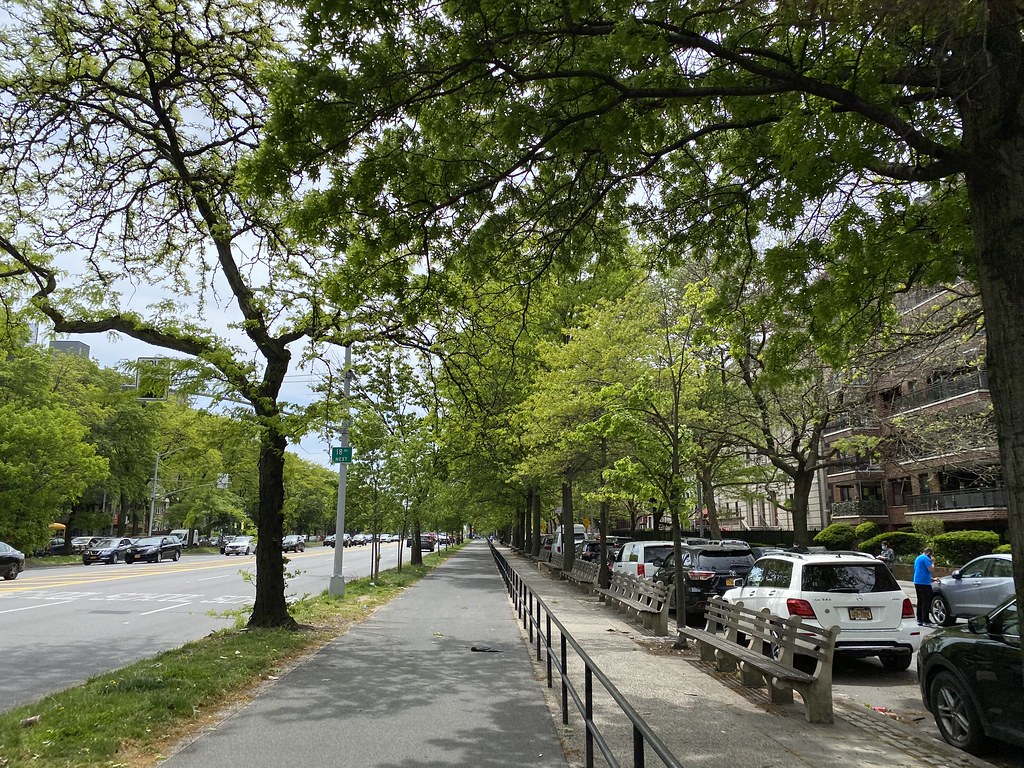My time with Tri-State Transportation Campaign has not only been an educational experience but has also changed my perspective on the infrastructure of cities in a way that will stay with me forever. As the summer progressed, I began to take note of and understand the systems around me. One day, inspired by my insights into active transportation, I decided to go out of my comfort zone and bike ride around areas I am typically only driven through. Despite being at least subconsciously aware of how car-centric much of New York’s infrastructure is, I was still surprised by the things I noticed in terms of how little space and safety is provided to commuters.
On my bike ride, which was confined to areas of South Brooklyn, two major issues stood out to me. One was that I saw no bike lanes; I have only ever seen one or two lanes in that section of Brooklyn throughout my life, but I was a good mile or so away from them. The vast majority of bike lanes in the borough are clustered in the commercial and high-income area of Downtown Brooklyn, rather than majorly residential neighborhoods. This pattern is visible throughout the city, with little progress being made—despite the fact that the NYC Streets Plan is supposed to mandate the addition of bike lanes. One possible cause is community opposition—despite the fact that Brooklyn is home to the oldest bike path in the country, located on Ocean Parkway, it remains a very car-centric area. Young children are often seen riding their bikes on the roads alongside large trucks and vehicles, which are driven by the neighborhood’s adults who vote against bike lanes because it would cost them a bit of their road space. In similar suburban communities in the outer boroughs, opposition to new protected bike lanes has come in the form of signs, petitions, etc., forcing plans to be altered to include only unprotected lanes. Even if there were such bike lanes where I was riding, the drivers I came across often treated stop signs as suggestions, meaning that my caution would only have been partially alleviated with the addition of a bike lane unless it were protected from motor vehicles. Bikers and pedestrians crossing the street seemed of little concern to those behind the wheel, discouraging them from supporting the addition of bike lanes (as they simply lack care for cyclists) and creating a significant safety concern.
While crossing the street felt unsafe, so did using the sidewalk. During my trip, I alternated between the sidewalks and roads often, finding that the roads were spacious and smooth; safe for a relative beginner during the rare times in which not many cars were in the area. I found that, on the contrary, the sidewalks were often unsuitable for riding since cracks were plentiful, large chunks of sidewalk jutted up to half a foot off the ground in some cases, and there were several tall curbs without any gradual slopes to the street. These drawbacks made for an unpleasant biking experience, but I can imagine that attempting to traverse the area as a wheelchair user would be far, far worse. While cars had nice roads with a lot of space, pedestrians had sidewalks as little as two feet across, with rugged terrain that made travel difficult for anyone and downright impossible for those who require mobility aids. It was abundantly clear that our infrastructure carried an underlying assumption—people should simply drive cars, and thus, no one should need to walk or travel in any other way.
As I continued my bike ride, I saw how this assumption—that our default mode of transport should be cars—permeated how we treat our transportation systems. Our country is built around car drivers; not pedestrians, not bikers, not transit riders, and certainly not people with disabilities, many of whom can only board their train at the roughly 1 in 4 stations that are ADA accessible (and as previously mentioned, accessed by unreliable sidewalks). Our roads, buses, and subways are reluctantly and poorly maintained, thrown aside in favor of highway expansions. Car drivers get convenience. Meanwhile, transit riders get malfunctioning trains and buses, able-bodied pedestrians and bikers get crumbling sidewalks, and the disabled are stuck taking Ubers.
Everywhere I travel now, I think back to a comment I heard at the office by Corey Hannigan, the Active Transportation Program Manager: A significant amount of space is taken up by cars; many “one lane” roads are actually three lane roads, with one for moving cars and two for parked cars. We devote so much of our space to cars that it feels as though our whole lives are built around them, despite the growing inconvenience of constant New York City traffic and obvious environmental drawbacks. It is crucial to change our mindsets; we need to devote resources into forms of travel that are accessible, equitable, and good for our planet and its inhabitants.
Fortunately, solutions are possible, although they may be difficult to achieve. One proposed answer for how to approach both the overuse of cars and the underfunding of transit was congestion pricing, which would have provided a consistent source of funding for the MTA to carry out service and accessibility upgrades: working elevators, better speakers, etc. As we see with bike lanes (and lack thereof), this was yet another improvement for non-car transit thrown away for the sake of car drivers. There are still other potential solutions; in terms of both biker and pedestrian travel, it would be helpful to have more bike lanes, both to make it easier for bikers as well as keep them off the sidewalks (which does have its risks, especially on narrower walkways). However, these lanes need to be physically separated from the roads, either via elevation or with the use of a parking lane, in order to help prevent accidents. Additionally, more money needs to be allocated towards sidewalk upkeep—I have seen entire roads paved and redone over one or two potholes, using money that could be far better spent in a way that makes it possible for people to walk. For the sake of the many New York residents who cannot or do not wish to rely on personal vehicles, action must be taken. We must ensure that all forms of transportation are possible for all.
Section of Flatbush Ave, South Brooklyn (four lanes for moving cars, plus one for parking, without any for bikes or buses!)

